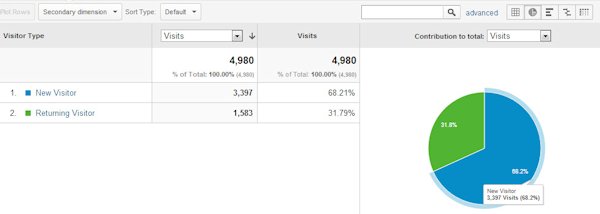The New vs Returning report in Google Analytics, found under Audience > Behavior, is a great place to understand how people who have been to your site before behave differently to those who are new to the site. However, there are also some important things to know about this report before basing too much on it.
Caveat: How Google Analytics Collects Data
Before we start analyzing the data, we need to know how it is collected.
Google Analytics uses cookies to track user’s behavior. With the classic asynchronous version of Google Analytics, these cookies are specific to the browser and device which is being used.
So when a user visits a site via their computer at home, then on their mobile phone, they will be classed as a new visitor on both occasions. If they then look at the site on their PC at work, they are a new visitor again. Likewise, if they clear their cookies on a device, they become a new user again.
This means that this report is often not 100 percent representative of user activity.
With Universal Analytics, the functionality attempts to resolve some of the previous discrepancies by tying each user’s activity together across different devices. However, this can only work when users log in to the website while browsing. For those websites where users log in, the data in this report should now be much more accurate.
What’s in the New vs Returning Report?
The report has two rows of data: New Visitor and Returning Visitor.
By default you see the site usage data which includes Visits, Pages per Visit, Average Visit Duration and Bounce Rate for each row. Immediately you can use this to see which one has a better interaction with the site and which you see more of.

The Pie Chart image is good to quickly visualize and report on what percentage of users are new or returning:

These two reports show that returning visitors have much better interaction data, but represent a smaller portion of the traffic. This immediately raises the goal to encourage visitors to return to the site.
By having Goals and Ecommerce tracking set up you can also see the two segments against conversions to see which is most valuable for your website. This can also help you work out whether you need to aim for more returning or new visitors:

Taking it Further
This report may be insightful, despite its discrepancies, however – why not track this yourself to avoid some discrepancies and include more than just new and returning visitors? You should set up Custom Variables to track different user types on your website.
This works by adding additional code to your Google Analytics tracking code. The code can be set to record different user types based on the activity of the user on the website.
So, if a user has been to the site and converted in the past you might want to call them an “existing customer”. For users who have been to the site before and visited lots of pages, but not converted you could call them a “browser”.
Here are two articles which highlight the possibilities of custom variables to help you get the most out of them, and understand your users better:
Time to Start Analyzing!
Using the New vs Returning reports will help you realize the potential for different types of visitors to your website and how you can best make the most of your traffic. Adding custom variables will take this analysis to the next level and really make the data matter more to you.
Whichever route you go down you can now plan your marketing campaigns more effectively to reach the best type of visitor.


